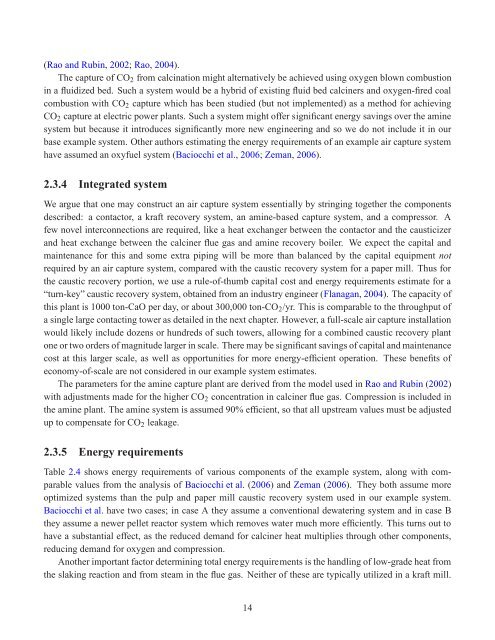Capturing CO2 from ambient air - David Keith
Capturing CO2 from ambient air - David Keith
Capturing CO2 from ambient air - David Keith
You also want an ePaper? Increase the reach of your titles
YUMPU automatically turns print PDFs into web optimized ePapers that Google loves.
(Rao and Rubin, 2002; Rao, 2004).<br />
The capture of <strong>CO2</strong> <strong>from</strong> calcination might alternatively be achieved using oxygen blown combustion<br />
in a fluidized bed. Such a system would be a hybrid of existing fluid bed calciners and oxygen-fired coal<br />
combustion with <strong>CO2</strong> capture which has been studied (but not implemented) as a method for achieving<br />
<strong>CO2</strong> capture at electric power plants. Such a system might offer significant energy savings over the amine<br />
system but because it introduces significantly more new engineering and so we do not include it in our<br />
base example system. Other authors estimating the energy requirements of an example <strong>air</strong> capture system<br />
have assumed an oxyfuel system (Baciocchi et al., 2006; Zeman, 2006).<br />
2.3.4 Integrated system<br />
We argue that one may construct an <strong>air</strong> capture system essentially by stringing together the components<br />
described: a contactor, a kraft recovery system, an amine-based capture system, and a compressor. A<br />
few novel interconnections are required, like a heat exchanger between the contactor and the causticizer<br />
and heat exchange between the calciner flue gas and amine recovery boiler. We expect the capital and<br />
maintenance for this and some extra piping will be more than balanced by the capital equipment not<br />
required by an <strong>air</strong> capture system, compared with the caustic recovery system for a paper mill. Thus for<br />
the caustic recovery portion, we use a rule-of-thumb capital cost and energy requirements estimate for a<br />
“turn-key” caustic recovery system, obtained <strong>from</strong> an industry engineer (Flanagan, 2004). The capacity of<br />
this plant is 1000 ton-CaO per day, or about 300,000 ton-<strong>CO2</strong>/yr. This is comparable to the throughput of<br />
a single large contacting tower as detailed in the next chapter. However, a full-scale <strong>air</strong> capture installation<br />
would likely include dozens or hundreds of such towers, allowing for a combined caustic recovery plant<br />
one or two orders of magnitude larger in scale. There may be significant savings of capital and maintenance<br />
cost at this larger scale, as well as opportunities for more energy-efficient operation. These benefits of<br />
economy-of-scale are not considered in our example system estimates.<br />
The parameters for the amine capture plant are derived <strong>from</strong> the model used in Rao and Rubin (2002)<br />
with adjustments made for the higher <strong>CO2</strong> concentration in calciner flue gas. Compression is included in<br />
the amine plant. The amine system is assumed 90% efficient, so that all upstream values must be adjusted<br />
up to compensate for <strong>CO2</strong> leakage.<br />
2.3.5 Energy requirements<br />
Table 2.4 shows energy requirements of various components of the example system, along with comparable<br />
values <strong>from</strong> the analysis of Baciocchi et al. (2006) and Zeman (2006). They both assume more<br />
optimized systems than the pulp and paper mill caustic recovery system used in our example system.<br />
Baciocchi et al. have two cases; in case A they assume a conventional dewatering system and in case B<br />
they assume a newer pellet reactor system which removes water much more efficiently. This turns out to<br />
have a substantial effect, as the reduced demand for calciner heat multiplies through other components,<br />
reducing demand for oxygen and compression.<br />
Another important factor determining total energy requirements is the handling of low-grade heat <strong>from</strong><br />
the slaking reaction and <strong>from</strong> steam in the flue gas. Neither of these are typically utilized in a kraft mill.<br />
14








